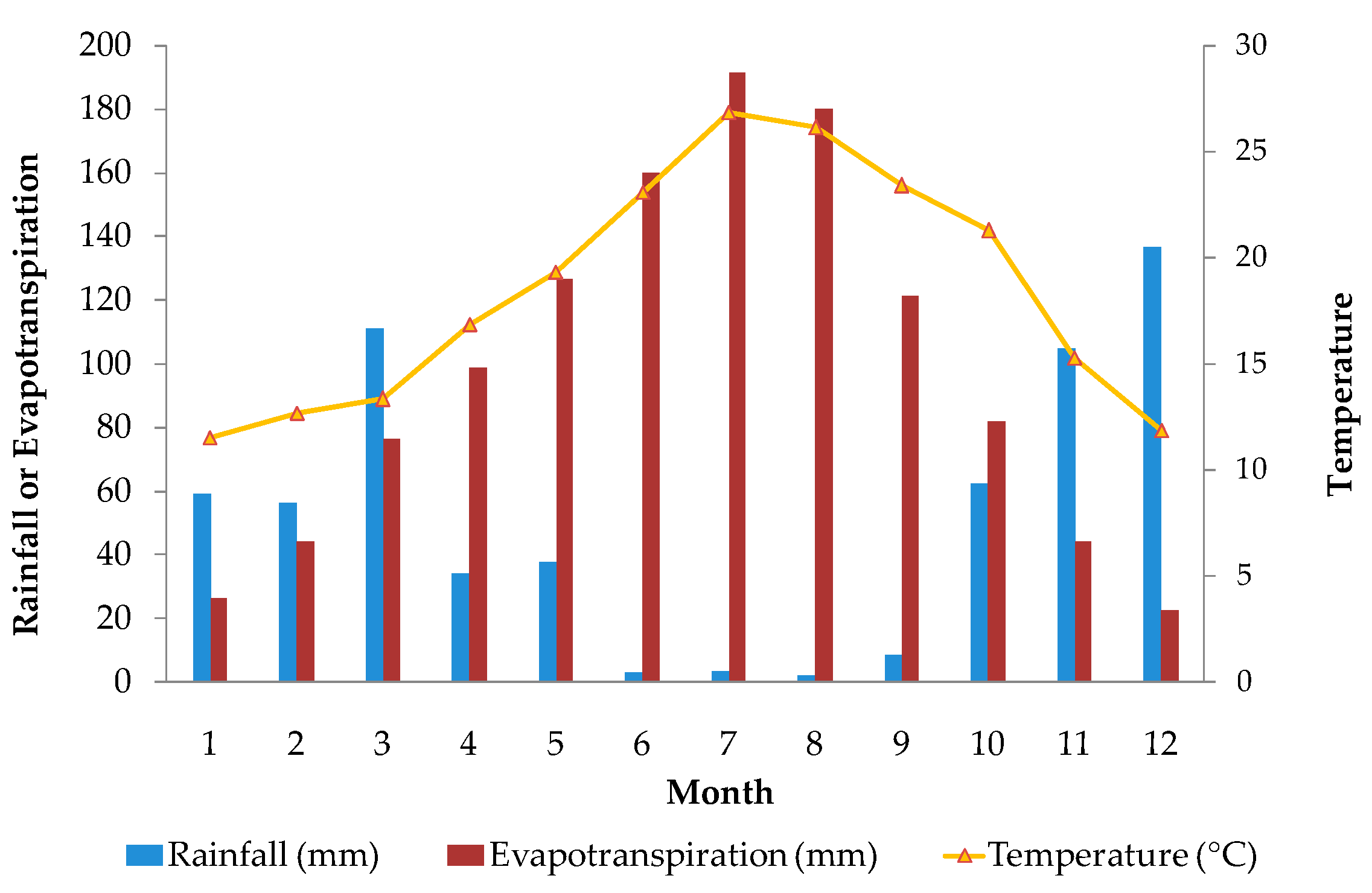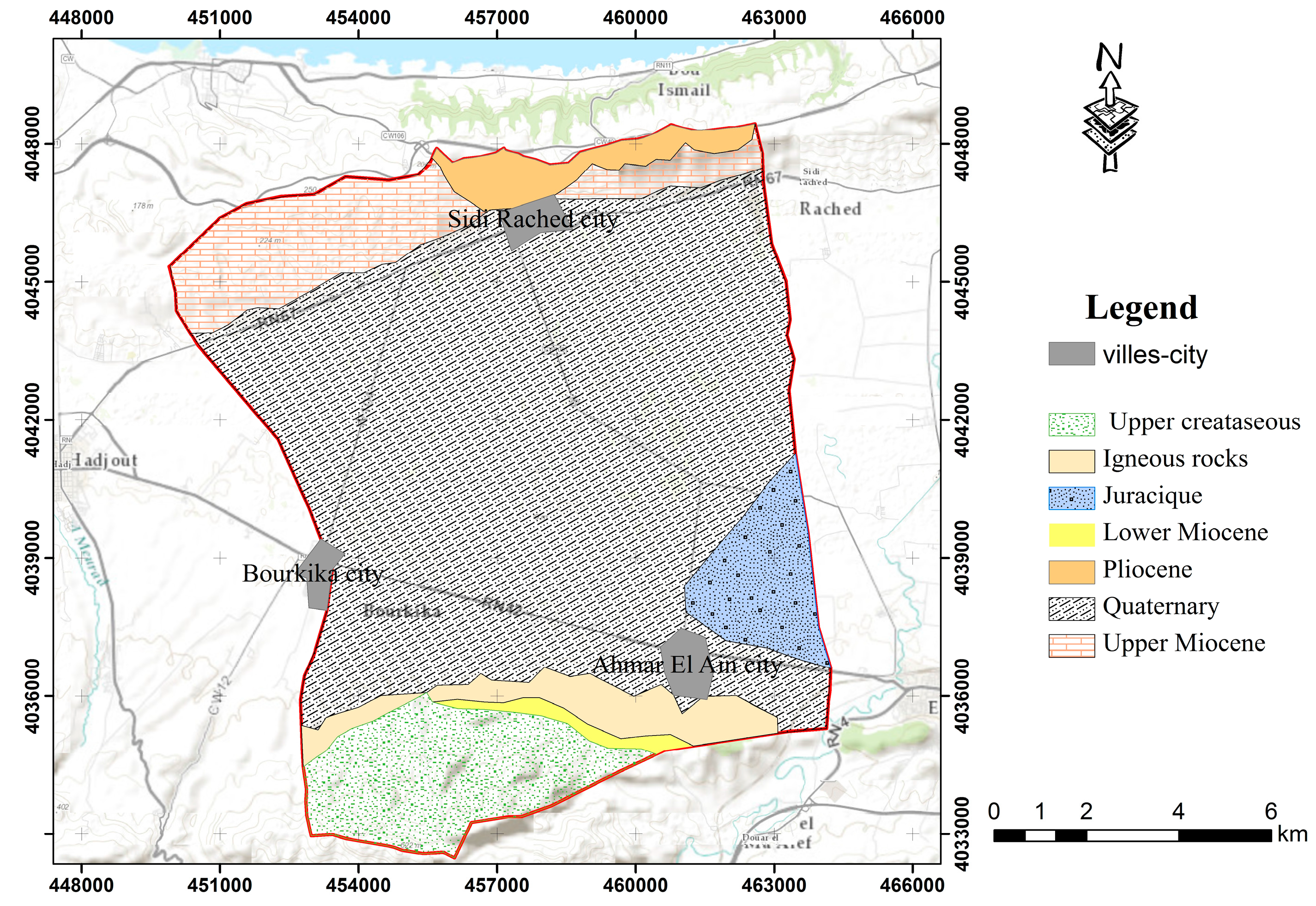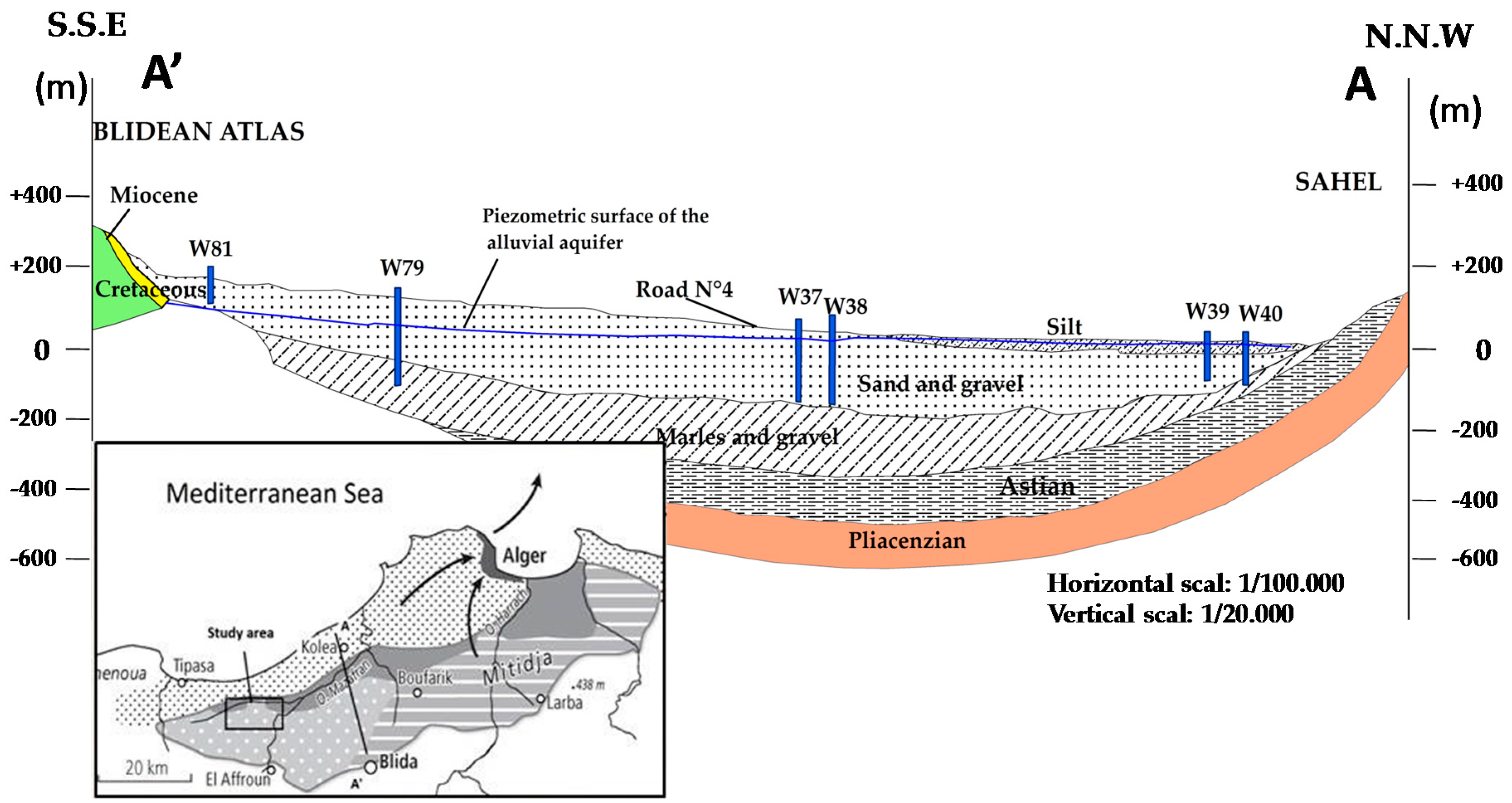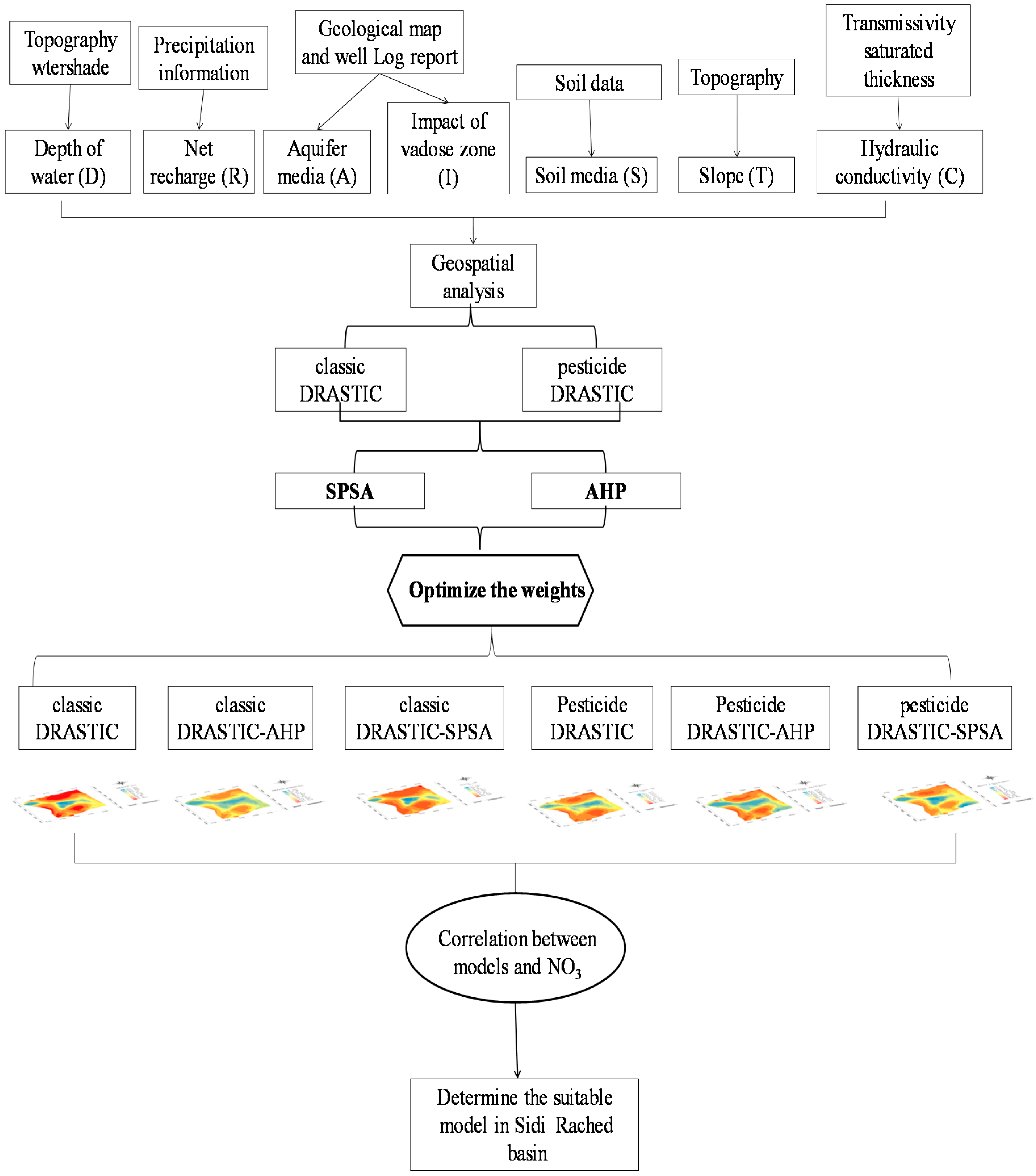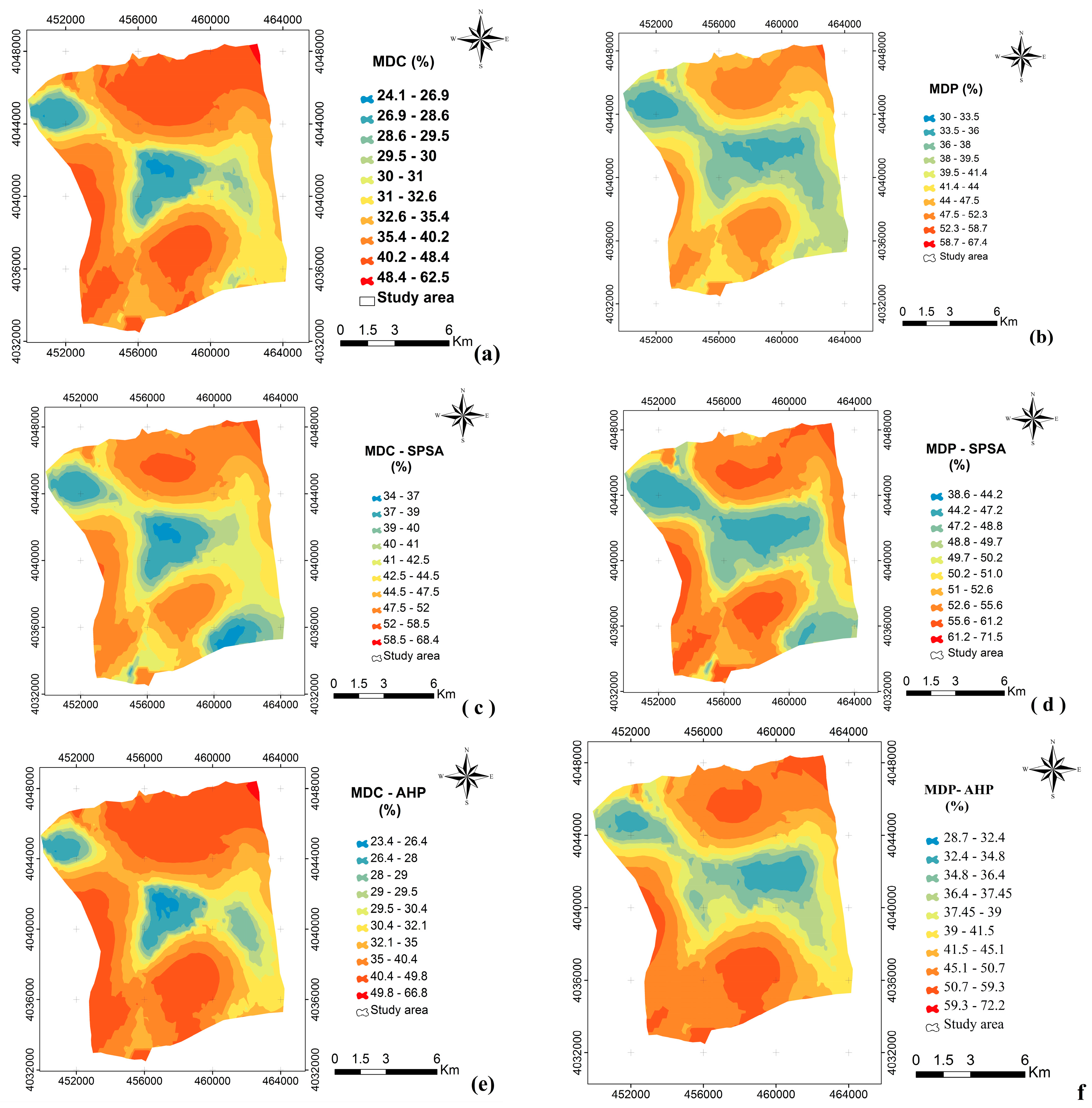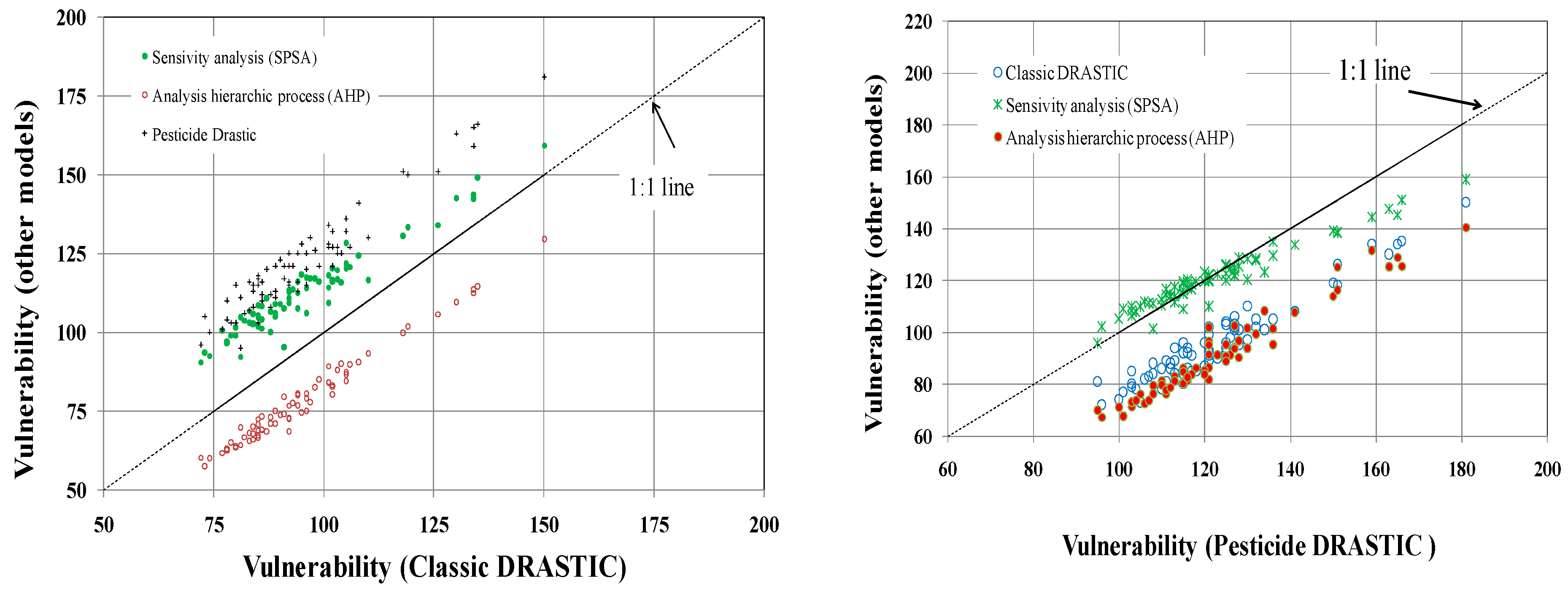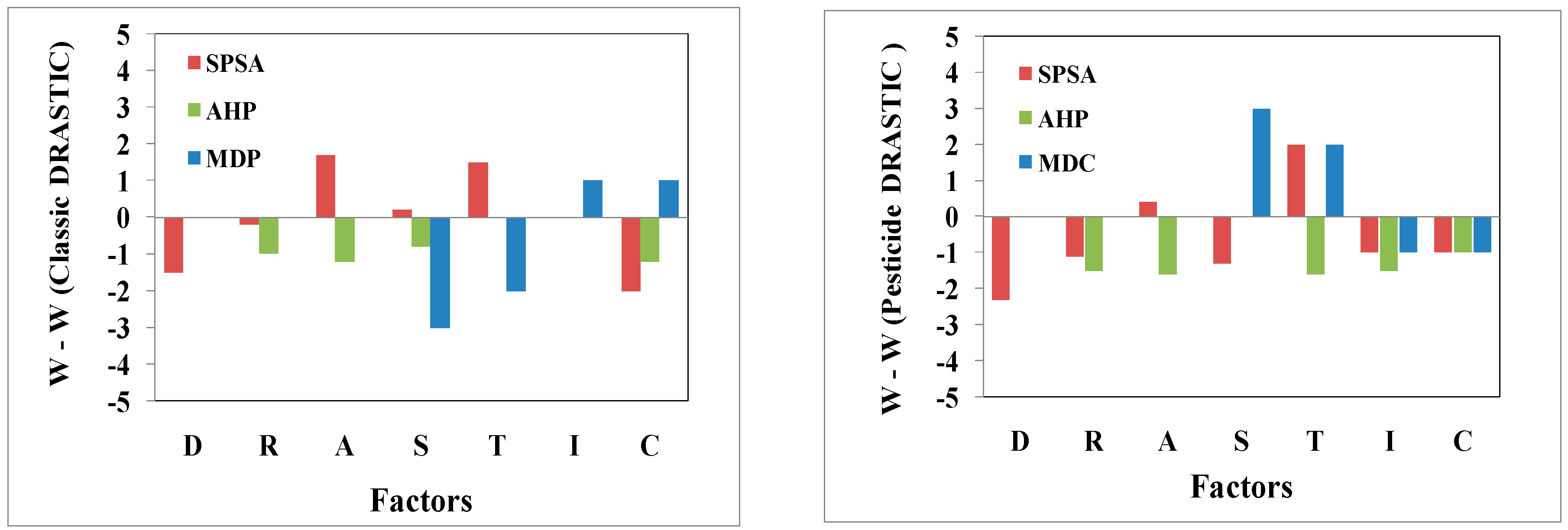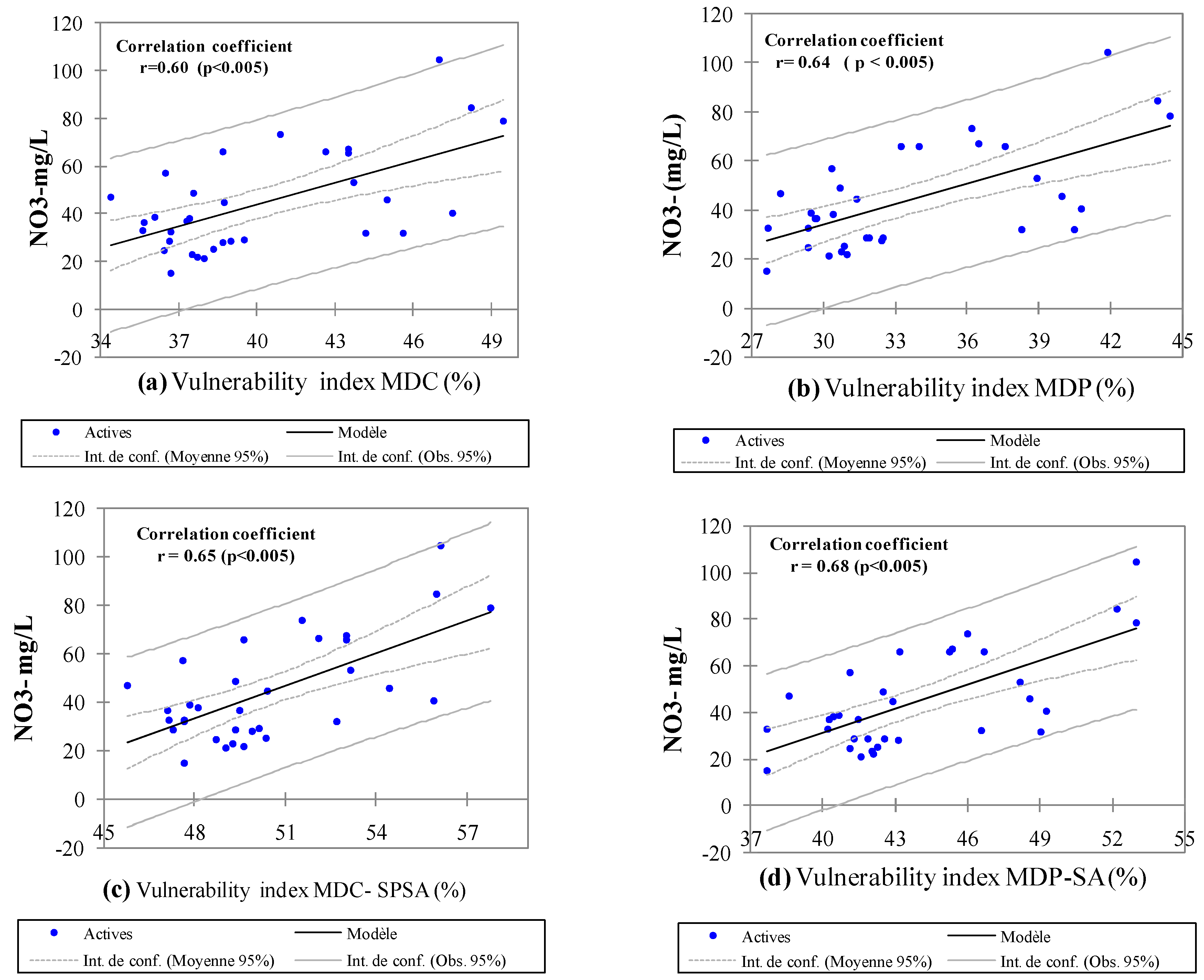4.1. Preparation and Processing of Data
The DRASTIC model with its seven parameters was derived from several data sets, the sources of which are presented in
Table 2.
Depth to water: Water table depths were obtained from boreholes provided by National Agency of Hydraulic Resources (ANRH). Data was extrapolated to the whole study area by using the kriging ordinary technique from the geostatistical extension “spatial analyst” of ArcGIS 10. The choice of the best surface was made based on the comparison of the different interpolation methods by the application of the cross-validation technique. The evaluation criteria are based on Mean Error (ME ≅ 0) values and root-mean square standardized error (RMSE ≅ 1) values. The exponential semivariogram model was the best-fitting model (
Figure 6 and
Table 5). A raster with the depth to water of the study area was reclassified into vulnerability values according to each height. The values range between 0.7 and 74.6 m. The average depth to water of the study area is 27.89 m (a shallow groundwater system), with a standard deviation of 12.69 m (
Table 4). Moreover, in
Table 4, the skew value is equal to 0.316, indicating that the distribution is moderately skewed with an asymmetric tail extending toward positive values. The calculated kurtosis value (3.052) is approximately 3, indicating that the distribution is normal. The parameters used in the interpolation and the associated semivariogram are shown in
Table 5 and
Figure 6.
Net recharge: Net recharge (R) represents the amount of water per unit area of land which penetrates the ground surface and reaches the water table. This recharge water is thus available to transport a contaminant vertically to the water table and horizontally within the aquifer [
24]. In addition, the quantity of water available for dispersion and dilution of the contaminant in the vadose zone and in the saturated zone is controlled by this parameter [
9]. Net recharge values were estimated based on precipitations by applying the model established by Mac Donald (1992) as a result of the hydroagricultural study of Mitidja plain, as follows:
R = (
P −
RT) ×
RP. This net recharge data was then extrapolated to the whole watershed area by using the kriging ordinary technique from Arcgis10. The best-fitting theoretical models and related semivariogram parameters were chosen to obtain the most accurate estimation, by evaluating eleven different models. The cross-validation was undertaken and estimated the net recharge values in the aquifer, and the circular semivariogram model was the best-fitting model (
Figure 6 and
Table 5). The cross-validation, which represents the accuracy of the predictions, shows that the mean error is close to 0 (0.0011) and that the standardized root mean square is close to one. The average annual net recharge values fluctuate considerably from one borehole to another, varying between an interval of 30 mm and 125 mm. The study area is characterized by an annual average rainfall ranging from 500 to 600 mm. More than 60% of the study area has low groundwater recharge rates (30–90 mm/year). The average annual net recharge of the study area is 78.88 mm with a coefficient of variation of 0.218 and a standard deviation of 17.19 mm (
Table 4). A skewness and kurtosis test were applied to characterize the net recharge (R) frequency and its distribution shape; the skew value obtained is equal to 0.44, indicating that the distribution is moderately skewed with an asymmetric tail extending toward positive values. The calculated kurtosis value is 3.02, indicating that the distribution is normal. The parameters used in the interpolation and the associated semivariogram are shown in
Table 5 and in
Figure 6.
Aquifer Media: This parameter represents the geological formation of the aquifer in the upper layer; it is prepared from the hydrogeological map and profiles of the boreholes. It governs the time and path followed by the contaminant to reach the water table; various formations have different degrees of permeability of the aquifer. The aquifer of Sidi Rached consists mainly of gravel and clay, clay and gravel, alluvium (mixture of clay, sand and gravel) of sand and limestone–marl and marl and clay. Index values were determined according to the classes reported in
Table 2.
Soil: The soil has a considerable impact on groundwater contamination by pollutants from the surface. It can reduce, delay or accelerate the spread of pollutants to the aquifer. The more soil is rich in clay, the more absorption of pollutants is important, and the more protection of groundwater is high. The information gathered from studies and soil maps has defined the nature of the soil. Index values were determined according to the classes reported in
Table 2. The distribution of soil taxonomy was obtained from digitalized soil maps of the Sidi Rached basin. Moreover, each soil subgroup was related to its texture according to study carried out in the area. The texture of subgroups was translated to DRASTIC ratings using
Table 2 [
24].
Topography: Topography is represented in DRASTIC by the slope of the land surface. At steep slopes, contaminants tend to move with the runoff water and therefore there is less pollutant retention and in turn little infiltration of contaminants will take place. On the other hand, shallow slopes have more potential for pollutant retention and in turn infiltration of contaminants. Then, the slope index was reclassified and converted into grid coverage and multiplied by the topographic weight. A model of the digital elevation study area ASTER GDEM version 2 of 30 m resolution was used in this study to calculate the percent slope. The slope was then classified according to the ranges criteria in
Table 2 via the ArcGIS 10. The topography map displayed a gentle slope (less than 6%) over most of the study area. The slope increases strongly in the south of the study area near the Blidean mounts.
Impact of the vadose zone: The vadose zone is defined as that above the water table which is unsaturated or discontinuously saturated. The nature of this area is an important parameter in the assessment of vulnerability, because it affects the speed of propagation of pollutants to the aquifer similar to the aquifer media (A). Its impact is determined from the lithology of land that constitutes it. The process of calculation and mapping theme “I” is the same as that of the saturated zone (A). It is obtained by the correlation of drill data and digitization of the geological map (scale 1/50,000). Different classes thus obtained are weighted from 1 to 9 by the DRASTIC model, with different degrees of vulnerability.
Hydraulic conductivity: The hydraulic conductivity values used to calculate the degree of vulnerability in our study area are obtained from pumping tests (are available as transmissivity). This net recharge data was then extrapolated to the whole watershed area by using the kriging ordinary technique from Arcgis10. The interpolation of the hydraulic conductivity calculated by Equation (3) allowed us to map the “C” parameter. The cross-validation was undertaken and the spherical semivariogram model was the best-fitting model (
Figure 6 and
Table 6). The cross-validation, which represents the accuracy of the predictions, shows that the mean error of hydraulic conductivity is close to 0 (0.0015) and that the standardized root mean square is close to one (0.98). Three classes of hydraulic conductivity were distinguished and indexed according to the DRASTIC model. A class of low values (0.36 × 10
−5 to 4.71 × 10
−5 m/s) is located to the north-east of the basin and represents only 2.24% of the total area; another class of mean values (4.7 × 10
−5 and 14.7 × 10
−5 m/s). Furthermore, a last class of high values is located north-west and south-west of the study area. The average hydraulic conductivity of the study area is 3.43 × 10
−5 m/s with a coefficient of variation of 0.933 and a standard deviation of 3.197 × 10
−5 m/s (
Table 4).
4.2. Classic DRASTIC and Pesticide DRASTIC Models
The ratings were attributed to the parameters taking into account their information and data which are presented in
Table 2 and are depicted in
Table 6. The vulnerability index of classic DRASTIC obtained was between 72 and 150; the spatial distribution is illustrated in
Figure 7a. Three (03) classes of vulnerability were identified: (
i) a class of low vulnerability occupying 65.4% of the total area of basin, located in the centre of the basin, northwest of the Sidi Rached city and southeast of the study area. That may be explained by the low permeability (0.4–2 × 10
−5 m/s) and low recharge (50–80 mm/year) in the centre and by the soil type (clay–loam–calcareous) and impact of the vadose zone (clay and sandstone) in the extremities of the basin area (northwest and southeast); (
ii) a second class of medium vulnerability to pollution, occupying 32.1% of the study area; (
iii) and a third class of high vulnerability, located near the city of Sidi Rached, Bourkika and Ahmar El Ain, representing 2.5% of the study area. The high vulnerability may be explained by the low depth to water (0.6–4 m) at the nearest city of Sidi Rached, by the high recharge (90–125 mm/year) and by the fact that agriculture is familiar, extensively using nitrogen fertilization.
The pesticide DRASTIC model uses the same thematic maps and the same grading as MDC but the weights of assigned parameters correspond to the MDP model [
24] (
Table 2). The vulnerability indexes of the pesticide DRASTIC model thus obtained were between 95 and 181 (
Figure 7b). This later allowed the definition of (03) three vulnerability classes: (i) a class of low vulnerability occupying 50% of the basin and located in its central part, northwest of the Sidi Rached city and at the southeast of the study area; (ii) a medium class occupying 38% of the study zone; and (iii) a high vulnerability class, occupying 12% of the global surface of the basin. It can be seen that the results are similar for both models except that values of the medium and high classes yielded by the pesticide DRASTIC model were superior to those of the classic DRASTIC model. This indicates the good capacity of the MDP model for diagnosing vulnerable areas and confirms the existence of a rural population in this part of the basin.
4.3. Optimized DRASTIC Models
In order to put forward a more realistic method to classify the groundwater vulnerability, the weights of the parameters of the classic DRASTIC and pesticide DRASTIC models were modified using two techniques: single parameter sensitivity analysis (SPSA) and Analytic hierarchic process (AHP). The weights of the parameters, thus obtained (
Table 7), were introduced into Equation (3) to calculate the vulnerability index (MDC–SPSA, MDC–AHP, MDP–SPSA and MDP–AHP).
According to these results, the impact of the vadose zone and the topography are the most important factors of vulnerability obtained by the application of the SPSA technique for the MDC and MDP respectively, while the hydraulic conductivity is the least important for both models (see
Figure 7c,d). According to the results of the AHP adjustment, the depth of the aquifer and the impact of the vadose zone are the parameters which have the highest weight for the MDC, whereas for the MDP, it is the impact of the vadose zone, type of soil (S) and the depth of the water which have the highest weights. On the other hand, the lowest parameters are the type of soil and the hydraulic conductivity for the MDC and MDP respectively (see
Figure 7e,f). The weight of the hydraulic conductivity factor (MDC–SPSA, MDP–SPSA and MDP–AHP) and type of soil (MDC–AHP) are rather small so the impact of this parameter in the related vulnerability index is residual. According to some authors [
19,
29], the redundant parameters must be eliminated from the vulnerability equations because it simplifies vulnerability assessments. However, this reasoning was not followed because we seek a comparison of the parameters’ weights resulted from the two adjustment techniques. The coefficients of
Table 7 are harmonized in a range of 1 to 5 (
Table 8).
The vulnerability index derived from the adjustment of the MDC and MDP parameters are listed in
Table 5 and comply with the following intervals: 72 ≤ MDC ≤ 150; 91 ≤ MDC–SPSA ≤ 159.3; 58 ≤ MDC–AHP ≤ 129.96; 95 ≤ MDP ≤ 181; 96≤ MDP–SPSA ≤ 159 and 61 ≤ MDP–AHP ≤ 136. In both cases, SPSA predicts the highest vulnerabilities and AHP the lowest. The corresponding vulnerability maps are illustrated in
Figure 7c–f.
4.4. Comparison between Vulnerability Indexes
Comparisons of the indexes arising from the adjustments applied to the parameters of MDC and MDP, with regard to the original (MDC and MDP), were performed (
Figure 8). The results show that the new MDC indexes estimated by the hierarchical analysis (AHP) deviate from the 1:1 line towards lower values with a rate that varies from 6% to 11%, and the indexes estimated by the single-parameter sensitivity analysis (SPSA) deviate towards higher values with a rate ranging from 3% to 13%. These adjustments are not constant but depend linearly on the MDC (
Figure 8).
MDC (SPSA) = 0.8 MDC + 35 (R = 0.93) and MDC (AHP) = 0.9 MDC − 8.8 (R = 0.97). However, the MDP index moves from the line 1:1 with a constant average margin of 25 points, because the confidence line adjusted to the dispersion points is parallel to the line 1:1, where the relationship between MDC and MDP is as follows: MDP = MDC + 25 (R = 0.92).
The MDP–AHP indexes deviate from the line 1:1 to lower values with a rate that varies from 15 to 33% (
Figure 7). However, the MDP–SPSA indexes deviate slightly from the line 1:1 (+ 8% to −12%). These adjustments depend linearly on the MDP (pesticide DRASTIC model): MDP (SPSA) = 0.66 MDP + 41 (R = 0.94), MDP (AHP) = 0.9 MDP − 21 (R= 0.95) and MDC = MDP − 25 (R = 0.92). Globally, the vulnerability indexes estimated by the models arising from weighting adjustments in the study zone deviate from the line 1:1 (MDC or MDP) with an average value of 20 points for a maximum value of 41 points. These differences represent an uncertainty of one to two classes of vulnerability, which are 20 points wide (
Figure 8). They can be explained by the difference of a model compared to the original models (MDC and MDP), and they pose the problem of consistency between the different techniques.
4.5. Comparisons among Weights
The variations in the weights estimated by Sensitivity Analysis and AHP, relative to the original DRASTIC values, were deduced from the data in
Table 6 and summarized in
Figure 9a,b. The largest difference in weight was observed between the MDC and MDP at the level of WS (around 3). The results obtained by the AHP process are either equal (WD, T and WI) or much lower than those obtained with the classic DRASTIC model (varies between −1.2 and −0.8); the underestimated parameter weights are WR, WA, WS and WC. Furthermore, the parameters that have the highest weights (=5) were not modified, namely D and I. The AHP technique retains the major importance of WD, WI and WT with slight reductions of other factors. Similar results were obtained by other authors [
13,
30,
31]. However, the weights resulting from the sensitivity analysis are different from the DRASTIC weights (MDC) except for WI (=5). Several studies have led to the same conclusions [
10,
14,
32].
A comparison of the parameters’ weights of classic DRASTIC with the harmonized weights resulting from the application of the adjustment techniques AHP and the sensitivity analysis was performed (
Figure 9). The results show that the WD, WI, and the WD, WT are almost unchanged, contrary to the residual variations in the other parameters (
Table 9). WI and the WD, WT have practically not changed; on the other hand, the weights of the other parameters have undergone changes of 0.2 to 2. The indexes calculated by AHP are highly correlated (R = 0.98 and 0.97 respectively for the MDC and MDP) compared with those calculated by the sensitivity analysis (R = 96 and R = 97 respectively for the MDC and MDP). The results obtained with the AHP technique on classic DRASTIC are significantly lower than those obtained by the pesticide DRASTIC model, except for WD and WS, or their initial weights were kept. The AHP technique maintains the importance of the highest parameters of both cases MDC (D and I) and MDP (D and S). Slight decreases were observed in the other parameters. The weights obtained by the sensitivity analysis technique were significantly lower than those of MDP except for WA and WT weights where we note an increase of 1.7 and 1.5 respectively. A final comparison between the original models (MDC and MDP) and the models resulting from weightings adjustment was carried out by calculating the correlation coefficients between the vulnerability indexes (
Table 9) where a good correlation between the different indexes of vulnerability was found (0.89 ˂ r ˂ 0.98).
4.6. Validation of the Vulnerability Index
The nitrate concentration was selected as the main parameter of the initial contamination to validate the original DRASTIC (MDC and MDP) models and the models resulting from the adjustment (SPSA–MDC, MDC–AHP, SPSA–MDP and MDP–AHP). Nitrate has been chosen because the study area is characterized by active agriculture, it is a good indicator for groundwater quality and its data is available. Data on the nitrate concentration refers to three measuring years: 2007, 2008 and 2009. A total of 34 boreholes that existed in the study area (Sidi Rached plain) are selected as sampling locations for the Nitrates analysis (
Figure 10). They are located in the aquifer alluvial quaternary (unconfined aquifer) with variable depths ranging from 50 to 100 m; this is in order to avoid intra-borehole artificial mixing which can often occur in wells, masking the real geochemistry of the aquifer. This phenomenon especially increases in the presence of old groundwater residing below younger groundwater in thick aquifers or oxidoreducing environments. The samples were collected with great care during low-flow pumping, in order to obtain samples with minimum disturbance from the in situ geochemical and hydrogeological conditions. In the case of the Sidi Rached plain where the study area is located, the wells are usually shallow so the assumption of homogeneity within the screen can be considered acceptable for a large-scale study. In addition, these boreholes have between two to five screens located at different levels depending on the constituents of the aquifer, the length of which varies from 6 to 20 m. Consequently, a uniform stratigraphic exists across these screened intervals. The samples collected were preserved in polyethylene bottles at low temperature and transferred to the laboratory ANRH (National Agency for Water resources) for the analysis.
Fundamental Statistics tests for nitrate concentrations were applied to characterize the location and variability of a data set (
Table 10); as can be seen, the nitrate concentration values fluctuate from one borehole to another varying between intervals of 15 and 104.6 mg/L. The average nitrate concentration in the study area is 44.4 mg/L, with a coefficient of variation of 0.5 and a standard deviation of 21.2 mg/L at the confidence interval of 0.95. The computed Kolmogorov–Smirnov test value (K–S = 0.2) at null hypothesis was less than the corresponding critical value of significance (
p = 0.654). Thus, the hypothesis regarding the distributional shape is not rejected, as the K–S value is smaller than the critical value of significance. In addition, as can be seen in
Table 10, the skew value is equal to 1.0, indicating that the distribution is moderately skewed with an asymmetric tail extending toward positive.
The correlations between the parameters are developed based on Pearson’s correlation method. The vulnerability indexes MDC–SPSA, MDP–SPSA, MDC–AHP and MDP–AHP are correlated with the nitrate concentrations of ground waters; we obtained 0.65, 0.68, 0.67 and 0.724 respectively. A significant improvement in the values of the correlation coefficient (R) was detected (
Figure 11), with regard to the original DRASTIC models MDC and MDP, which were of 0.60 and 0.64 respectively.
The best correlation is that of MDP–AHP (R = 0.724) followed by MDP–SPSA (R = 0.68). This shows that the MDP model best explains the vulnerability index which coincides with other studies. Nitrate concentrations were found to be in the range of 15–104.6 mg/L and the average is close to the allowed limit (44.4 mg/L). The vulnerability index values of the corresponding points were determined from vulnerability index maps (
Figure 7a–f). Calculated coefficient values are always much greater than Pearson’s critical value. Therefore, correlations are highly significant at the 1% probability level. The selection of a model to quantify the vulnerability in a region is not a straightforward task, requiring expertise and additional information to be set satisfactorily because one bad choice may lead to excessive constraints in regions forecasted as highly vulnerable.
Our choice was made according to two criteria: (i) have a better correlation between the vulnerability index and nitrate concentrations; (ii) weights must be proportional to the range of the ratings [
33]. In this case, the recommended model to quantify the vulnerability in the study area (Sidi Rached) would be MDP–AHP.

